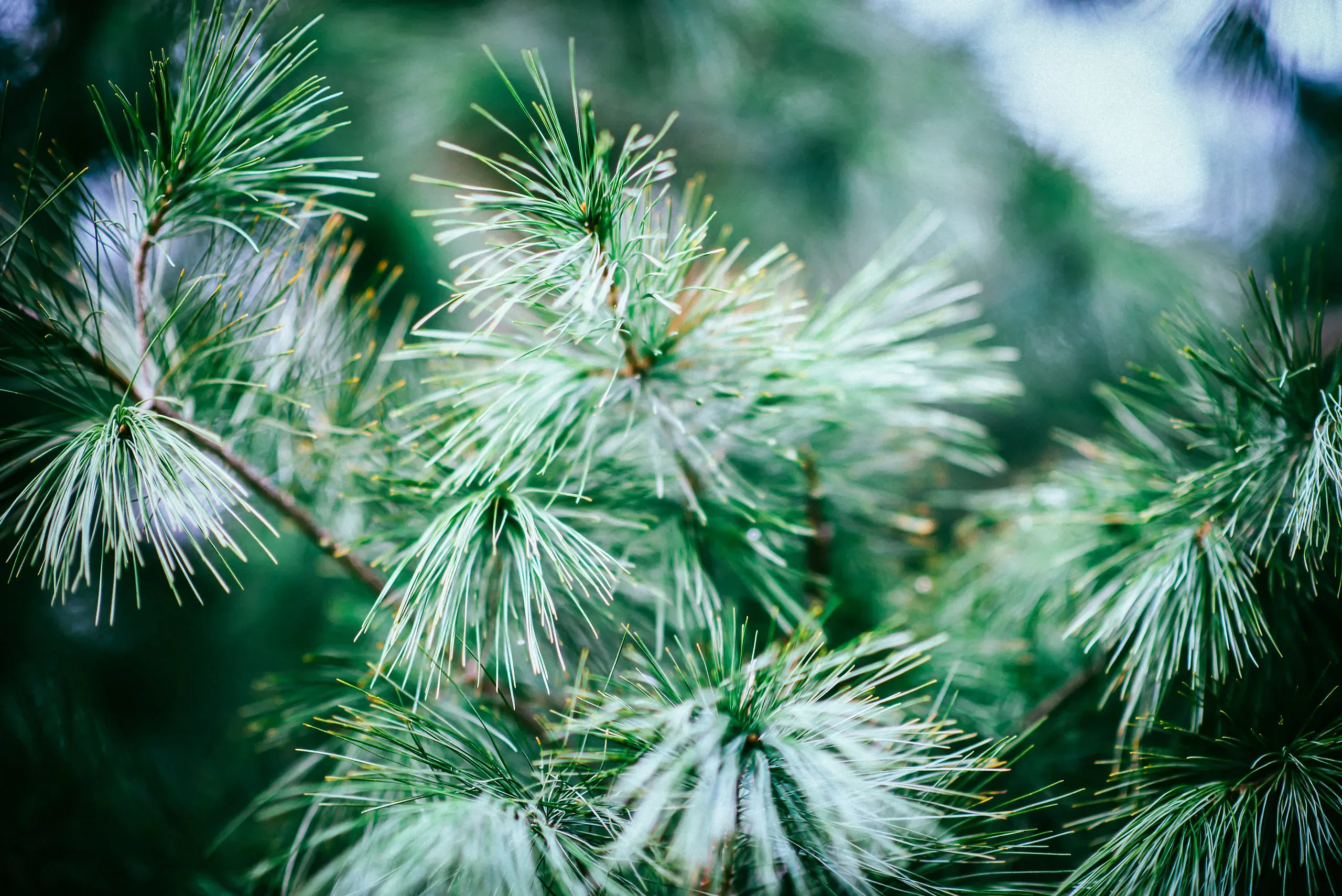
Planting Guides How to Plant Evergreen Trees
The moment has arrived – your new trees have been delivered and you are about to plant them in your garden. These trees are going to be with you for many years to come, so it is worth taking a little time to give them the best start possible, so that they can give you their very best too. This guide is our general guide for all pot-grown trees that keep their leaves in winter, called evergreen trees. These could be broad-leaf evergreens like Southern magnolia, or needle-trees like spruce, pine or Thuja. We have various guides for other types of trees, so check our site if your tree is not an evergreen.
In a Nutshell
- Remove all packaging
- Water the tree in its pot
- Choose a suitable planting site for the needs of your tree
- Prepare the soil
- Dig a hole the depth of the pot
- Put the tree in its hole and replace most of the soil
- Water well, let the water drain and put back the rest of the soil
- Put a mulch around your tree and water once a week for the first season
Remove your trees from the box
The very first thing to do is un-wrap your trees. Remove all the wrapping materials, remove the trees from the box and remove any wrapping around the trees themselves.
If you see that your tree is growing in a plastic pot, you are reading the correct guide.It is also possible that your evergreen tree has its roots wrapped in burlap and rope. If that is the case, see our guide for planting Ball & Burlap trees, which applies to both deciduous and evergreen trees.
When you need to move your plant around, do it by picking up the pot – do not lift it by the trunk or stem.
Care Before Planting Time
Your trees have been on a journey and they will be a little stressed, so place them in a shady part of your garden and give them a good watering. Do not put them in the garage, a shed or in the house, even if it is cold outside. Do not remove them from the pot. If you are not going to be doing the planting for a little while, that is fine, they will be happy in their pots, but if your tree is a sun-loving tree, after a day or two in the shade, move it to a sunny location. Remember to water every day or every second day, depending on how warm the weather is – do not let the pot become completely dry. If it does become very dry, place it in a bucket and half-fill the bucket with water so that the soil can soak completely.
Choosing a Planting Location
Once your tree has been planted it is best not to try and move it again, so spend some time deciding exactly where to plant it. Look at its needs for sun or shade and choose a suitable spot in your garden for it. Consider how wide it is going to grow and allow enough space from buildings in particular, but also from fences and walls.
If you plant right on your property line your neighbor has a legal right to cut back your tree to the property line, which may not look very nice, so plant well inside your property so that you have control over growth and pruning of your own trees. If you are planting a screen or hedge, we have special guides for planting hedges, windbreaks and privacy screens.
Preparing the Planting Site
Good soil preparation is the key to the success of your tree. Whatever your soil is like, use it. Do not try to dig a hole and fill it with soil you bought somewhere else. If your soil is poor, just use extra organic material.
You goal is to make a large area of looser soil that the young roots can penetrate easily, getting food as they go and establishing quickly. You need to have an area at least three times the diameter of the pot dug as deep as your spade will go. Add some organic material to the soil as you dig. Almost any kind of organic material is good, among the best are well-rotted cow, sheep, or horse manure (if you can obtain them); garden compost; any ‘top-soil’ from a garden centre; or if you have nothing else, peat-moss. A bucket per tree is about right, but any amount you have is worthwhile. In addition, trees need fertilizer to help develop their roots. This can be rock phosphate or bone-meal or any kind of superphosphate. There are many ‘tree planting’ fertilizers available too and they all work well, so whatever is available will be fine.
Remove roots of weeds from the area and any stones bigger than your fist. Smaller stones can be left and it is not a good idea to sieve the soil to remove smaller stones they are best left in and can help with drainage.
Turn over the soil, mixing the organic material and fertilizer into it and then level it off and get ready to plant. Save some of the organic material you used to mulch your tree after planting.
Preparing the Tree
The evening before you are going to plant, give the pots a good soaking with water. If the root-ball is dry when you plant, it may stay that way and cause your tree to suffer from dryness even if the surrounding soil is damp.
Digging the Hole
Now dig a hole in the exact spot where you want your tree to be, making it two or three times the diameter of the pot, but only just as deep. If you have dug the soil deeper than that, use your foot to press down the soil in the bottom of the hole, to form a firm base beneath the tree. This is to prevent it from sinking deeper than you want in the hole after you have planted it.
Removing the Pot
Take your tree to the planting hole and slide the pot gently off. You may need to tap the edge a couple of times to release the roots, but it should slide out pretty easily. Usually there will be plenty of roots filling the pot and the root-ball will stay together and not fall apart at all.
The key to success in planting evergreen trees is to keep the root-ball undisturbed. Do not shake off soil or cut the roots. If it seems that the root-ball inside the pot is not solid, and this can happen, it is quite normal, then leave your tree in its pot, take a sharp knife and cut around the bottom of the pot and remove the base. After you have the tree positioned in its hole and some soil in place to stabilize its, you will cut down the sides of the pot in one or two places and gently slide the pieces out of the hole, leaving the root-ball undisturbed.
Planting the Tree
Now place the tree in the centre of your hole, checking that the top of the root-ball is level with the soil around it. Replace about three-quarters of the soil in the hole, pressing it down around the roots of your tree. If you have left the pot on, do the same thing, but when you have finished, cut the pot together and gently work the cut pot out of the soil. Finish firming down the soil – a gentle foot pressure or firm hand pressure is about right.
Watering the Tree
Now fill the hole with lots of water, letting it soak down into the ground and into the root ball. Use plenty of water and then wait until it has all drained away. This will give plenty of water around the roots, where it is needed.
Finishing the Planting
Now put back the rest of the soil, firming it gently down. Make sure you have only covered the top of the root ball with a very little soil, no more than one inch. Make sure the soil is not sloping away from the tree, but flat, so that when you water it will stay around the tree, not run away. Some gardeners like to make a low wall of soil around the tree, at a spot about twice the diameter of the pot, to retain water. This is a fine thing to do, but not absolutely necessary. Put a layer of organic material over the root area, about two inches deep and then water the whole area thoroughly.
Planting in Clay and Wet Soils
If you have heavy, clay soil that stays wet for long periods, there is a special trick to planting which will help your tree establish itself better. Rake some of the soil from the edges of your planting area into the centre, to build a slightly-raised mound. Plant your tree on this mound and additionally, leave the top inch of the root-ball above the final surface of the soil after planting. This will help water to drain away around the roots until your tree adapts to the location. You should still use mulch over the roots.
Staking
Normally staking is not necessary. Modern arborists prefer to let the wind strengthen the tree, and stakes often cause breakage of the upper part of your tree.
In a very windy location two short stakes, well driven in but showing just a foot or so above the soil, can be used. Place these on opposite sides of the tree, outside the area where the roots are. If the prevailing wind is, for example, from the north, then place one stake on the north side and one on the south side. Wrap some cloth around the trunk to protect it and tie a strong rope from each stake to the trunk. Some remaining movement in the upper part of the tree is fine, it does not have to be held rigidly, and in fact that is not a good idea. A stake high up into the tree is normally not necessary and can do more long-term harm than good.
If you have used stakes, remove them after one growing season, once the roots are well-established.
Follow-up Care of the Tree
Until your tree is established and has spread out its roots, it will need regular watering. How often depends on the weather, but a good, slow soaking once a week is usually best, or twice a week if the weather is hot. Soak the whole area around the tree, not just up against the trunk
So that is it. Your new evergreen tree is set for a great life and will reward you with vigorous growth and year-round healthy foliage. A little care really pays off.
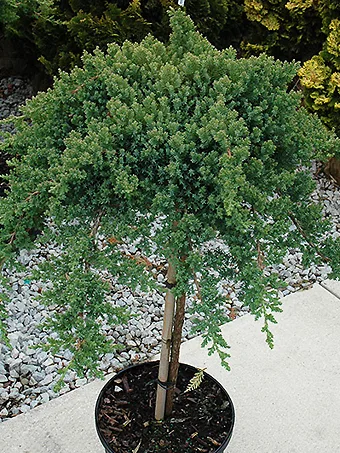
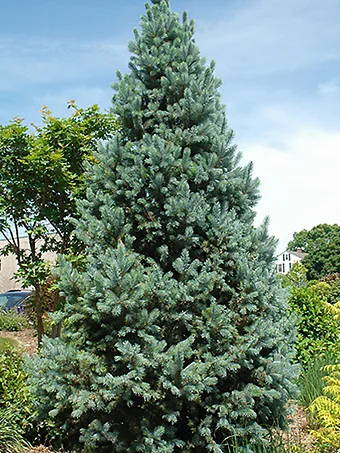
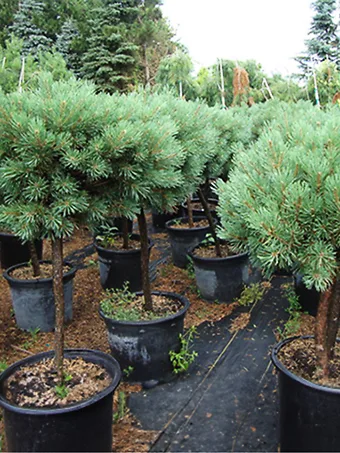
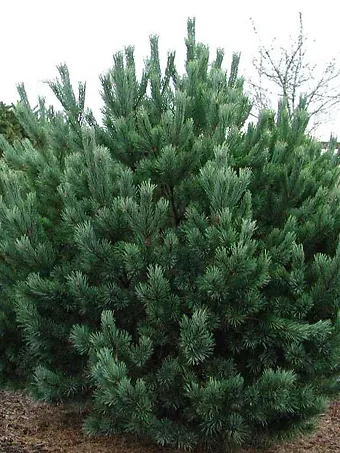
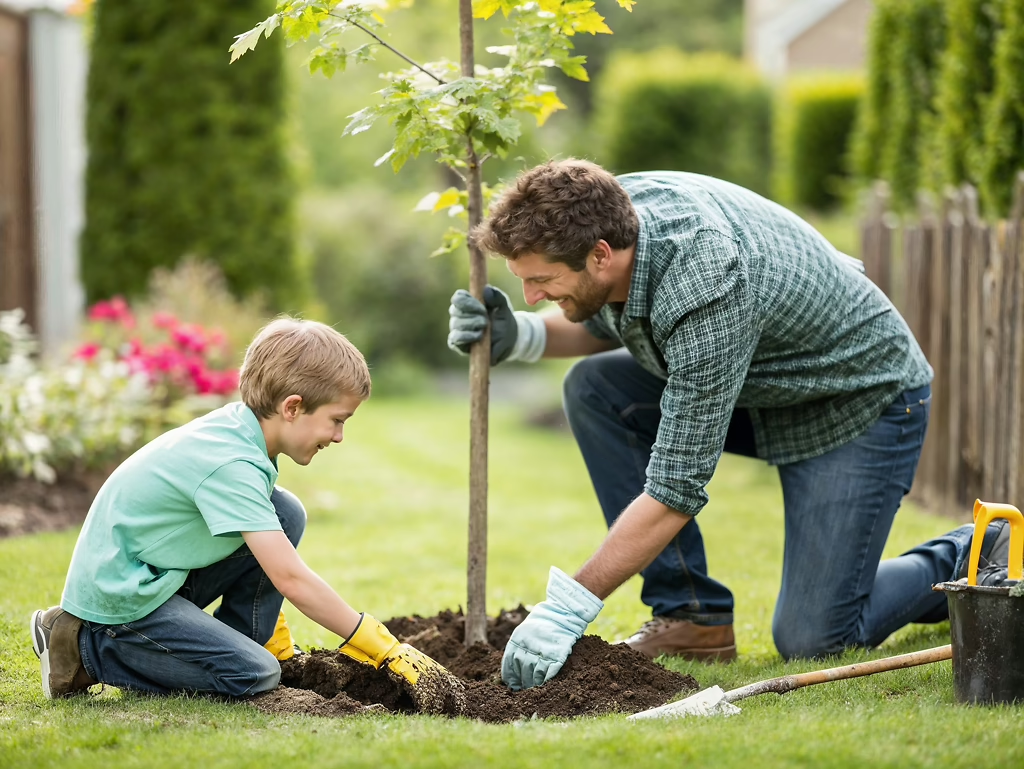
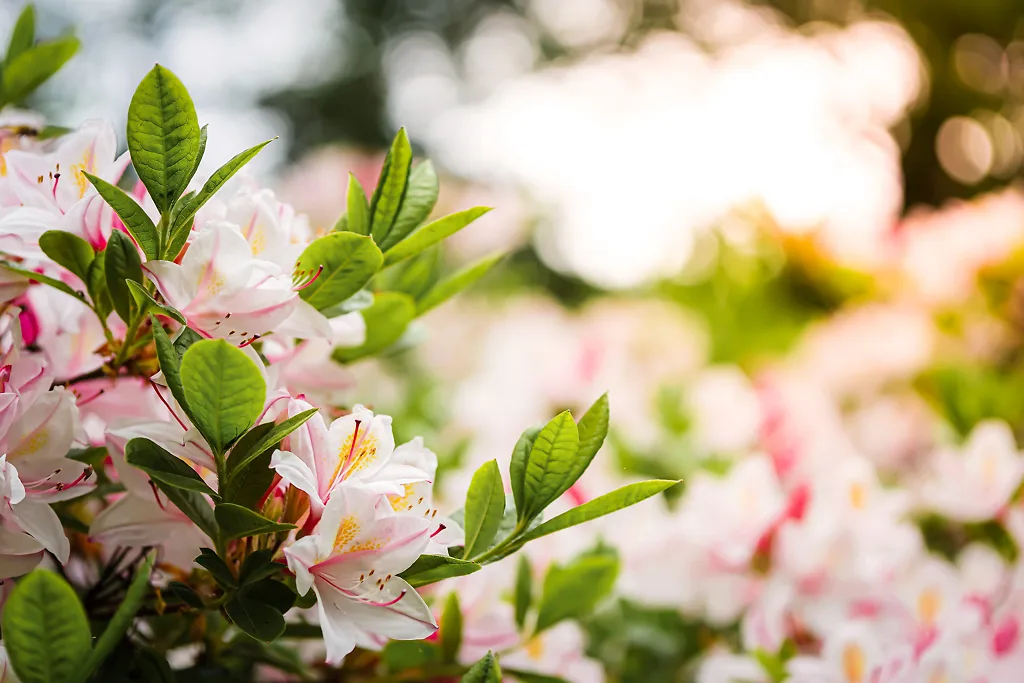






Comments 23 comments
How far apart should baby blue spruce be planted if pla ting in a row?
The trees I ordered are beautiful and very good size. They were packed perfectly.
Thank you so very much for a great product, good price and good service.
Julia
Hi. I need 3 to 4, 8 foot tall evergreen trees to plant in my Albuquerque , New Mexico yard. What would you suggest.
I have property in CO at 9600ft if elevation but in our “banana belt”, which gets less moisture than most mountain areas. I want to plant a tree in memory of my father who recently passed but unsure which species would be hardy for the dry conditions at elevation. I have mostly aspens and a few pine trees. I believe the pines are ponderosa pines as they have rather sturdy horizontal branches and sparse needle coverage overall.
This was VERY helpful. How warm does The soil need to be before I can put it in the ground? I’m in zone 4. Daytime temps have been in high 40’s low 50’s. Nights down to the 30’s. I ordered evergreens.
This was VERY helpful. How warm does The soil need to be before I can put it in the ground? I’m in zone 4. Daytime temps have been in high 40’s low 50’s. Nights down to the 30’s. I ordered evergreens.
How big are the white pines in the one gallon size?
I will be planting our Japanese yew evergreen in a pot, any suggestions for a successful planting.
I bought three leyland cypress. Planted a month ago. Since then the have given no indication they are establishing. No, all I see are leaves drying out and the bottom half turning brown. I want these trees to grow but I am totally bewildered. What is going on l? I need guidance.
Can you grow the Serbian spruce indoors?
It new from the tree center in a 3 gal pot.
How often to water it?
My evergreen arrived in beautiful shape with ties in three locations to a stake., forming a beautiful zig zag shape. The top of the tree is long and I am wondering if that part of the tree will lift up as it receives more sun and watering or if I need to adhere it to the stake like the other three tie downs? I don’t want to break it by lifting it up and staking it. What is your recommendation?
I would like a privacy hedge. How far apart should I plant my arbor vitae trees? As well, what type of fertilizer do you recommend plus is wood mulch ok to use around the trees after planting?
How big is #2 #3 etc. containers.
Question: Can I plant Chamaecyparis nootkatensis ‘Green Arrow’ in a container and how for best results. I wnt to grow it close to the house and I am worries about the roots damaging the foundation so I thought a container might be possible.
Hello,
I have ordered a Ponderosa pine for my property. It states it is good through Zone 8. I live in Brazos County, Tx, specifically College Station, Tx. This is within Zone 8. I am reading now on other sites that this tree may not work in this area. Do you know if this tree will have any problems growing in our area.
Regards,
Stacy
I live in Morris Ct 06763
My ground is frozen and I received two trees from my son for Christmas. A Colorado blue spruce and a fat Albert blue spruce.
I watered them upon arrival. I will put outside on front porch steps where natural rain can keep watered. I am in a moderate snow zone for winter. I plan to leave them there for the winter in semi dormancy. Please advise if this sounds like a good plan for them.
Can you please give us directions on how to plant your lollipop 1 gallon evergreen/spruce into a pot? I don’t want to ever plant him in the ground, so that I can keep him with me when I move. Thank you.
Can you please give us directions on how to plant your lollipop 1 gallon evergreen/spruce into a pot? I don’t want to ever plant him in the ground, so that I can keep him with me when I move. Thank you.
Can you please give us directions on how to plant your lollipop 1 gallon evergreen/spruce into a pot? I don’t want to ever plant him in the ground, so that I can keep him with me when I move. Thank you.
Can you please give us directions on how to plant your lollipop 1 gallon evergreen/spruce into a pot? I don’t want to ever plant him in the ground, so that I can keep him with me when I move. Thank you.
Can you please give us directions on how to plant your lollipop 1 gallon evergreen/spruce into a pot? I don’t want to ever plant him in the ground, so that I can keep him with me when I move. Thank you.
hello….
I planted my Emerald Green Arbovitae on 8/24, shortly after receiving them.
I believe I followed the planting instructions
. The limbs appear to be dyifrom the inside out. Ie interior limbs turning yellow, exterior are still green.
Is this a sign of too much water or not enough?
hello….
I planted my Emerald Green Arbovitae on 8/24, shortly after receiving them.
I believe I followed the planting instructions
. The limbs appear to be dyifrom the inside out. Ie interior limbs turning yellow, exterior are still green.
Is this a sign of too much water or not enough?